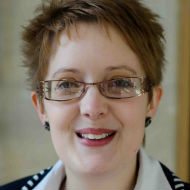Laura Varnam
Lecturer in Old and Middle English Literature

Contact information
Teaching
I teach Medieval Literature and Linguistics to the English undergraduates at Univ. In the first year, students learn to read Old English poetry, such as Beowulf and The Wanderer, in the original language and to think about the connections between the early medieval period and the present day, via Tolkien’s Lord of the Rings and modern translations of Beowulf by Seamus Heaney and Maria Dahvana Headley. In the Linguistics course we examine how the English language has changed over time and we explore concepts such as Standard English and dialect; the relationship between language and identity (e.g. gender, sexuality, and race); and the impact of social media and the internet on modern English. Close textual analysis is at the forefront of my teaching and in the second year, students study Middle English literature from the fourteenth and fifteenth-centuries, including named authors such as Chaucer, the Gawain-poet, Thomas Hoccleve, and Margery Kempe, and an array of anonymous texts such as lyrics, romances, and biblical plays. I am a great believer in the importance of reading aloud and I run a regular Chaucer Reading Group during which we read The Canterbury Tales and Chaucer’s masterpiece Troilus and Criseyde. I use visual art and material culture as part of my teaching and regularly arrange hands-on sessions at the Ashmolean Museum to study Anglo-Saxon objects and late medieval devotional aids such as pilgrimage badges. More recently I have experimented with creative writing in both my teaching and research, and I have written a poetry collection inspired by the women of Beowulf.
Research
My medieval research focuses on fourteenth and fifteenth-century religious literature and my first book, The Church as Sacred Space in Middle English Literature and Culture, was published by Manchester University Press in January 2018. The book explores the church as a building, a community, and an idea and thinks about how medieval Christians were taught to understand the church as a consecrated space by examining a range of texts including sermons, architectural allegories, and a church foundation legend.
I also work on the fifteenth-century mystical text The Book of Margery Kempe and in April 2018 I co-organised a landmark conference on The Book at Univ with Dr Laura Kalas. At the conference we launched the Margery Kempe Society, which promotes and supports scholarship and teaching on The Book, and we have edited a new and innovative essay collection, Encountering The Book of Margery Kempe, forthcoming from Manchester University Press in November 2021. My next medieval book project focuses on Margery Kempe.
With my other research ‘hat’ on, I am an expert on the life and works of Daphne du Maurier and I am working on a book which argues that du Maurier should be redefined as a major twentieth century literary talent. I regularly appear at the Fowey Festival of Arts and Literature in Cornwall running events on du Maurier and in 2017 I was interviewed as part of a new documentary on du Maurier for the European culture channel Arte, Daphne du Maurier: Sur les traces de Rebecca (‘in the footsteps of Rebecca’).
Selected Publications
Books
Encountering The Book of Margery Kempe, ed. Laura Kalas and Laura Varnam (Manchester University Press, forthcoming November 2021)
The Church as Sacred Space in Middle English Literature and Culture (Manchester: Manchester University Press, 2018).
Articles and Chapters
‘A Revelation of Love: Christianity, Julian of Norwich and Medieval Pity in the Harry Potter Series’, Studies in Medievalism, 29 (2020), 155-82
‘Coarseness, Power, and Masculinity in Daphne du Maurier’s The Infernal World of Branwell Brontë’, Brontë Studies, 44.1 (2019), 109-22
‘“Þe ȝatez stoken watz neuer ȝet”: London, the New Jerusalem, and the Materiality of “Entre” in Pearl and The Pilgrimage of the Lyfe of the Manhode’, in Studies in the Age of Chaucer, 40 (2018), 401-21
‘The Importance of St Margaret’s Church in The Book of Margery Kempe: A Sacred Place and an Exemplary Parishioner’, Nottingham Medieval Studies, 61 (2017), 197-243
‘Synne to shewe, vs to frame: Representing the Church in Robert Mannyng’s Handlyng Synne’, Leeds Studies in English, 48 (2017), 89-104
‘The Crucifix, the Pietà, and the Female Mystic: Devotional Objects and Performative Identity in The Book of Margery Kempe’, Journal of Medieval Religious Cultures, 41.2 (2015), 208-37
‘Church’, in A Handbook of Middle English Studies, Blackwells Critical Theory Handbooks, ed. Marion Turner (Blackwells: 2013), pp.299-314.
‘The Book of the Foundation of St Bartholomew’s Church: Consecration, Restoration, and Translation’ in Sacred Text, Sacred Space: Architectural, Spiritual, and Literary Convergences in England and Wales, ed. Joseph Sterrett and Peter Thomas (Brill: 2011), pp.57-75.
‘Sanctity and the City: Sacred Space in The Life of St Werburgh’, in Mapping the Medieval City: Space, Place, and Identity in Chester c.1200-1500, ed. Catherine A. M.Clarke (University of Wales Press: 2010), pp.114-130.
‘Chaucer: The Canterbury Tales and Troilus and Criseyde’, in The Cambridge History of English Poetry, ed. Michael O’Neill (Cambridge University Press: 2010), pp. 81-95.